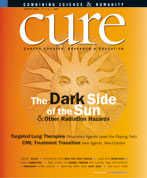Publication
Article
CURE
v4n2 - Connecting Online
Author(s):
I am awed when I consider that billions of electrical impulses traversing networks of computers worldwide have created a haven for people who share a terrifying disease.
My mother is in the habit of lighting candles in honor of people she has never seen before.
Likewise, people who have never met my mom, whose name is Carol Rogers, also light candles with her in mind. These are virtual candles, not made of wax and wicks. They are tiny, animated things burning on the World Wide Web, their yellow flames buffeted by perpetual, imaginary winds.
The candle lighters are part of a listserv, an e-mail-based server that allows users to create, manage and control electronic “mailing lists” on a network, in this case www.breastcancer.org. My mom’s once straight hair was growing in as tight and curly as a spring lamb’s coat when she first logged on and read some of the postings from fellow breast cancer survivors.
She’d never been particularly drawn to the Internet, but soon she was telling me about the women she’d “met” online. “Champagne’s situation is a lot like mine,” Mom would say, referring to another poster by her web handle. “She also had stage 2 invasive ductal carcinoma, with no node involvement.”
Soon Mom—“Birch” to her new friends—was logging on multiple times a day to read news about how the first post-mastectomy date went for “Selena,” or to send a reassuring note to a newly diagnosed poster. Women by the hundreds were adding posts every hour, comparing notes on the mundane and the overwhelming physical and emotional responses to the disease.
Mom has become particularly close to a dozen or so women who celebrate one another’s recovery milestones and mourn each other’s setbacks. One terrible month last summer, two of them were stricken anew with cancer. Even as the candles were lit and the fervent prayers posted, both “DCgal” and “Precocious” died.
Selfishly I wondered whether Mom’s grief would impede her own healing. Choosing my words as carefully as I could, I reminded her of the many list participants who are getting better, including her. She wrote back that she had decided to limit her use of the list—a little bit, anyway.
“I make a place inside for cancer to live,” she said to me later. “And when it comes out, I send it back to its place. I’m getting better at it.”
Her comment helped me recognize that Mom’s “cyber-sisters” are uniquely positioned to support her in her recovery. While her local friends lovingly sustained her with casseroles, get-well cards and gifts left on the doorstep, none but those who have lain back to receive the chemo drip or donned the wig can truly grasp the enormity. As Mom’s friend “DarkEyes” e-mailed to me recently, “We have all stared down the tunnel of our own mortality and have experienced some kind of shift because of this. I think that binds you, like people who have been in a war together. You just know.”
Of course DarkEyes, Birch and all the others could reap benefits by meeting with other survivors in person, but scheduling or space limitations could limit such gatherings. With this listserv and others out there like it, women know they’ll always have someone, in some time zone, to “talk to” on a night when cancer looms large in the darkness, and the escape of sleep refuses to come.
When I was a reporter, I wrote about the high-tech world for almost a decade, covering the speeds of the routers that underpin the Internet, yet focusing little on the human connection it enables. I am awed when I consider that billions of electrical impulses traversing networks of computers worldwide have created a haven for people who share a terrifying disease.
Mom and Dad have now met twice, in person, with small groups of the breastcancer.org women and their partners; they shop, take walks, eat and talk. I haven’t met them yet, but from time to time, I light a candle in their names. My gratitude to them is as boundless as the cyberspace that led my mother to a virtual place where authentic hope burns brilliantly.






